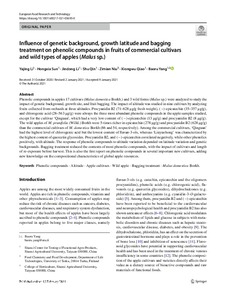| dc.contributor.author | Xiongwu Qiao Xiongwu | |
| dc.contributor.author | Qin Shu | |
| dc.contributor.author | Li Yajing | |
| dc.contributor.author | Niu Zimian | |
| dc.contributor.author | Sun Hongxia | |
| dc.contributor.author | Yang Baoru | |
| dc.contributor.author | Li Jindong | |
| dc.date.accessioned | 2022-10-28T14:29:37Z | |
| dc.date.available | 2022-10-28T14:29:37Z | |
| dc.identifier.uri | https://www.utupub.fi/handle/10024/171687 | |
| dc.description.abstract | <p>Phenolic compounds in apples 17 cultivars (<a></a><a><i>Malus domestica</i></a><i> </i>Borkh.) and 3 wild forms (<i>Malus </i>sp.) were analyzed to study the impact of genetic background, growth site, and fruit bagging. <a></a><a>The impact of altitude was studied in nine cultivars by analyzing fruits collected from orchards at three altitudes. Procyanidin B2 (71–628 </a>mg/g fresh weight), (−)-epicatechin (35–357 mg/g), and chlorogenic acid (28–563 mg/g) were always the three most abundant phenolic compounds in the apple samples studied, except for the cultivar ‘Qinguan’, which had a very low content of (−)-epicatechin (13 mg/g) and procyanidin B2 (8 mg/g). The wild apples of <i>M. prunifolia </i>(Willd.) Borkh<i> </i>were 5-times richer in epicatechin (278 mg/g) and procyanidin B2 (628 mg/g) than the commercial cultivars of <i>M. domestica </i>Borkh (86 and 54, respectively). Among the commercial cultivars, ‘Qinguan’ had the highest level of chlorogenic acid but the lowest content of flavan-3-ols, whereas ‘Liuyuehong’ was characterized by the highest content of quercetin glycosides. Procyanidin B2, and (−)-epicatechin correlated negatively, while other phenolics positively, with altitude. The response of phenolic compounds<a></a><a> to altitude variation </a>depended on latitude variation and genetic backgrounds. Bagging treatment reduced the contents of most phenolic compounds, with impact of cultivars and length of re-exposure before harvest. This is also the first report on phenolic compounds in several important new cultivars, adding new knowledge on the compositional characteristics of global apple resources.</p> | |
| dc.language.iso | en | |
| dc.publisher | Springer | |
| dc.title | Influence of genetic background, growth latitude and bagging treatment on phenolic compounds in fruits of commercial cultivars and wild types of apples (Malus sp.) | |
| dc.identifier.url | https://link.springer.com/article/10.1007/s00217-021-03695-0 | |
| dc.identifier.urn | URN:NBN:fi-fe2021042826808 | |
| dc.relation.volume | 247 | |
| dc.contributor.organization | fi=elintarviketieteet|en=Elintarviketieteet| | |
| dc.contributor.organization-code | 2610103 | |
| dc.converis.publication-id | 51869560 | |
| dc.converis.url | https://research.utu.fi/converis/portal/Publication/51869560 | |
| dc.format.pagerange | 1149 | |
| dc.format.pagerange | 1165 | |
| dc.identifier.eissn | 1438-2385 | |
| dc.identifier.jour-issn | 1438-2377 | |
| dc.okm.affiliatedauthor | Yang, Baoru | |
| dc.okm.discipline | 415 Muut maataloustieteet | fi_FI |
| dc.okm.discipline | 414 Agricultural biotechnology | en_GB |
| dc.okm.discipline | 1182 Biokemia, solu- ja molekyylibiologia | fi_FI |
| dc.okm.discipline | 415 Other agricultural sciences | en_GB |
| dc.okm.discipline | 414 Maatalouden bioteknologia | fi_FI |
| dc.okm.discipline | 1182 Biochemistry, cell and molecular biology | en_GB |
| dc.okm.internationalcopublication | international co-publication | |
| dc.okm.internationality | International publication | |
| dc.okm.type | Journal article | |
| dc.publisher.country | Sveitsi | fi_FI |
| dc.publisher.country | Switzerland | en_GB |
| dc.publisher.country-code | CH | |
| dc.relation.doi | 10.1007/s00217-021-03695-0 | |
| dc.relation.ispartofjournal | European Food Research and Technology | |
| dc.year.issued | 2021 | |
